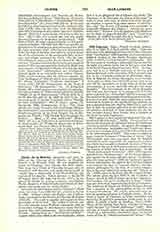

Olivier de la Marche, chronicler and poet, b. 1426, at the Chateau de la Marche, in Franche-Comte; d. at Brussels, 1501. He was knighted by Count de Charolais, later Charles the Bold (1465). Two years later Count de Charolais became ruler of Burgundy and Flanders, and made Olivier bailiff of Amont (now a department of the Haute-Saone) and captain of his guards. Taken prisoner at the battle of Nancy, where the duke lost his life (1477), he regained his liberty by paying a ransom, and rejoined Marie, daughter of Duke Charles and heiress of Burgundy, who made him her maitre d’hotel.
As a writer he is best known by his “Memoirs”, which cover the years from 1435-92, first printed at Lyons in 1562. Another edition, by Beaune and d’Arbaumont, was made for the Societe de l’Histoire de France (1883-88). The work is singular and important for a knowledge of the period. The author is sincere, but his style contains many Wallonne expressions and, as in his other writings, he introduces too many descriptions of fetes and tournaments. Most of his works are in verse. Among these are: “Le Chevalier Delibere”, a poem which some think is his own biography, others that it is an allegorical life of Charles the Bold; “Le Parement et le Triomphe des Dames d’Honneur”, a work in prose and verse, of which each of the twenty-six chapters is named from some articles of ladies’ attire; and “La Source d’Honneur pour maintenir la corporelle elegance des Dames”. Among his prose works are: “Traite et Avis de quelques gentilhommes sur les duels et gages de bataille”, and “Traite de la Maniere de celebrer la noble fete de la Toison d’or”.
GEORGES BERTRIN

